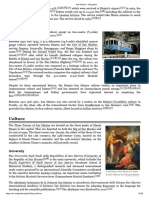Rock Art of The Iberian Mediterranean Basin: Ain Sakhri Lovers
Rock Art of The Iberian Mediterranean Basin: Ain Sakhri Lovers
Uploaded by
Jerome BrusasCopyright:
Available Formats
Rock Art of The Iberian Mediterranean Basin: Ain Sakhri Lovers
Rock Art of The Iberian Mediterranean Basin: Ain Sakhri Lovers
Uploaded by
Jerome BrusasOriginal Title
Copyright
Available Formats
Share this document
Did you find this document useful?
Is this content inappropriate?
Copyright:
Available Formats
Rock Art of The Iberian Mediterranean Basin: Ain Sakhri Lovers
Rock Art of The Iberian Mediterranean Basin: Ain Sakhri Lovers
Uploaded by
Jerome BrusasCopyright:
Available Formats
Compared to the preceding Upper Paleolithic and the following Neolithic, there is rather less
surviving art from the Mesolithic. The Rock art of the Iberian Mediterranean Basin, which probably
spreads across from the Upper Paleolithic, is a widespread phenomenon, much less well known
than the cave-paintings of the Upper Paleolithic, with which it makes an interesting contrast. The
sites are now mostly cliff faces in the open air, and the subjects are now mostly human rather than
animal, with large groups of small figures; there are 45 figures at Roca dels Moros. Clothing is
shown, and scenes of dancing, fighting, hunting and food-gathering. The figures are much smaller
than the animals of Paleolithic art, and depicted much more schematically, though often in energetic
poses.[10] A few small engraved pendants with suspension holes and simple engraved designs are
known, some from northern Europe in amber, and one from Star Carr in Britain in shale.[11] The Elk's
Head of Huittinen is a rare Mesolithic animal carving in soapstone from Finland.
The rock art in the Urals appears to show similar changes after the Paleolithic, and the
wooden Shigir Idol is a rare survival of what may well have been a very common material for
sculpture. It is a plank of larch carved with geometric motifs, but topped with a human head. Now in
fragments, it would apparently have been over 5 metres tall when made. [12] The Ain Sakhri
Lovers from modern Israel, are a Natufian carving in calcite.
You might also like
- Comparison of Scottish and Irish GaelicDocument1 pageComparison of Scottish and Irish GaelicDoc Hhm BhuvadiaNo ratings yet
- History of Ireland in 100 ObjectsDocument231 pagesHistory of Ireland in 100 Objectsmiseans100% (1)
- By Emma GroeneveldDocument8 pagesBy Emma GroeneveldbababNo ratings yet
- 2nd Mesolithic Dec 2023Document8 pages2nd Mesolithic Dec 2023Samia LatifNo ratings yet
- Prehistoric ArtDocument20 pagesPrehistoric Artcplo2148qcNo ratings yet
- Cave of LascauxDocument5 pagesCave of LascauxAira ManaboNo ratings yet
- Viking JewelryDocument30 pagesViking JewelryAnneli KrNo ratings yet
- Split 8370212300475334906Document4 pagesSplit 8370212300475334906thakurmtnandiniNo ratings yet
- Prehistoric ArtDocument17 pagesPrehistoric ArtMarina KennedyNo ratings yet
- Aditya Singh 2016130 Sofo 1st Year Assignment2Document8 pagesAditya Singh 2016130 Sofo 1st Year Assignment2Aditya SinghNo ratings yet
- Pres Historic ArtDocument15 pagesPres Historic ArtPaolo EscoberNo ratings yet
- The Birth of ArtDocument6 pagesThe Birth of ArtLOLNo ratings yet
- Viking Ship MuseumDocument17 pagesViking Ship MuseumÖzhanÖztürkNo ratings yet
- Palaeolithic ArtDocument10 pagesPalaeolithic ArtNeeraj MundaNo ratings yet
- The Bronze Age Petroglyphs of BohuslänDocument7 pagesThe Bronze Age Petroglyphs of Bohuslänpa_ule_ttaNo ratings yet
- Paleo (Prehistoric Times) Lithos (Stone) : Paleolithic EraDocument3 pagesPaleo (Prehistoric Times) Lithos (Stone) : Paleolithic Erajan kenneth palanogNo ratings yet
- Ħal Saflieni Hypogeum - UNESCO World Heritage CentreDocument3 pagesĦal Saflieni Hypogeum - UNESCO World Heritage CentreEdgar Iván EscobarNo ratings yet
- Cave Paintings Are A Type ofDocument4 pagesCave Paintings Are A Type ofJordan MosesNo ratings yet
- ArtApp Worksheet2 @2EFGDocument8 pagesArtApp Worksheet2 @2EFGFelix NepumocenoNo ratings yet
- Valdes, The Gazelle Jar' From Tell Qara QûzâqDocument16 pagesValdes, The Gazelle Jar' From Tell Qara QûzâqCarmen Valdés PereiroNo ratings yet
- Olmec Civilization by Dr. S.N. SureshDocument20 pagesOlmec Civilization by Dr. S.N. Sureshdrsnsuresh100% (3)
- Evolution of The CeltsDocument10 pagesEvolution of The CeltsJ BossNo ratings yet
- Dewil Valley Cave ComplexDocument10 pagesDewil Valley Cave ComplexQueen Dunhill CruzNo ratings yet
- History of Arts Lecture 1-ADocument15 pagesHistory of Arts Lecture 1-ASamia LatifNo ratings yet
- D.ovcharov-15 Skarbów Bułgarii PDFDocument90 pagesD.ovcharov-15 Skarbów Bułgarii PDFWaldemar BednarzNo ratings yet
- Cave ArtDocument1 pageCave ArtNestor RubiaNo ratings yet
- Venus of Willendorf, Also Called Woman of Willendorf or Nude WomanDocument16 pagesVenus of Willendorf, Also Called Woman of Willendorf or Nude WomanIzzat SabriNo ratings yet
- Full Article BednarikDocument12 pagesFull Article BednarikNeetumishti ChadhaNo ratings yet
- Hansen Ljubljana-LibreDocument14 pagesHansen Ljubljana-LibreSamra TerzicNo ratings yet
- Michael Alene Opal Export Business PlanDocument8 pagesMichael Alene Opal Export Business PlanAsere Jazmin0% (1)
- Foundation: The History of England from Its Earliest Beginnings to the TudorsFrom EverandFoundation: The History of England from Its Earliest Beginnings to the TudorsRating: 4 out of 5 stars4/5 (187)
- Stone Age ArtsDocument10 pagesStone Age ArtsMoppet SampedroNo ratings yet
- Discuss The Following Questions, Alternately, Find Answers For ThemDocument2 pagesDiscuss The Following Questions, Alternately, Find Answers For Themvinoth KumarNo ratings yet
- Inga Merkyte Ezero-KaleDocument77 pagesInga Merkyte Ezero-KaleivansuvNo ratings yet
- PRE HISTORIC ART - ScriptDocument3 pagesPRE HISTORIC ART - ScriptVeronica AgrabioNo ratings yet
- British Culture and CivilizationDocument218 pagesBritish Culture and Civilizationhereg daniela100% (3)
- Art of Prehistory: C. BCE BCEDocument81 pagesArt of Prehistory: C. BCE BCElily100% (3)
- Lascaux Cave InfoDocument3 pagesLascaux Cave Infogna riNo ratings yet
- Iron Age: Chronology Iron Working Life in The Iron Age Iron Age European SitesDocument34 pagesIron Age: Chronology Iron Working Life in The Iron Age Iron Age European SitesAdrian CadizNo ratings yet
- Palaeolithic AgeDocument5 pagesPalaeolithic AgeRamita Udayashankar100% (1)
- Key Elements:: Art Pieces Stone AgeDocument9 pagesKey Elements:: Art Pieces Stone AgeHanie FordNo ratings yet
- Prehistoric Architecture in BritainDocument6 pagesPrehistoric Architecture in BritainLoana LuluNo ratings yet
- Moche-Chimu Cultures.Document10 pagesMoche-Chimu Cultures.Elisvan Joel PerezNo ratings yet
- Atestat EngleazaDocument8 pagesAtestat Engleazazaharie ionutNo ratings yet
- @hiddenhistorybtDocument3 pages@hiddenhistorybthiddenhistorybelfastNo ratings yet
- Ruin Islanders: Thule Culture Pioneers in the Eastern High ArcticFrom EverandRuin Islanders: Thule Culture Pioneers in the Eastern High ArcticNo ratings yet
- DolmenDocument5 pagesDolmenBrittany MayerNo ratings yet
- My Favourite Finds at HerculaneumDocument2 pagesMy Favourite Finds at HerculaneumSam OliverNo ratings yet
- History of Ancient Civilization by Charles SeignobosDocument249 pagesHistory of Ancient Civilization by Charles SeignobosLuis RuizNo ratings yet
- VVAA. Rock Art. Gci. 2006Document32 pagesVVAA. Rock Art. Gci. 2006Trinidad Pasíes Arqueología-Conservación100% (1)
- San Marino: HistoryDocument4 pagesSan Marino: HistoryJerome BrusasNo ratings yet
- Railway: CultureDocument4 pagesRailway: CultureJerome BrusasNo ratings yet
- Government: Enlargeable, Detailed Map of San MarinoDocument4 pagesGovernment: Enlargeable, Detailed Map of San MarinoJerome BrusasNo ratings yet
- See Also: The World Factbook Encyclopædia Britannica Gov - SMDocument4 pagesSee Also: The World Factbook Encyclopædia Britannica Gov - SMJerome BrusasNo ratings yet
- Suite (Music) - WikipediaDocument5 pagesSuite (Music) - WikipediaJerome BrusasNo ratings yet
- Hamburg: Hamburg Free and Hanseatic City of HamburgDocument4 pagesHamburg: Hamburg Free and Hanseatic City of HamburgJerome BrusasNo ratings yet
- Population: TourismDocument4 pagesPopulation: TourismJerome BrusasNo ratings yet
- Facilities and Communication Policies: Powell v. WardDocument4 pagesFacilities and Communication Policies: Powell v. WardJerome BrusasNo ratings yet
- Hector Berlioz - WikipediaDocument7 pagesHector Berlioz - WikipediaJerome BrusasNo ratings yet
- Polyphony - WikipediaDocument7 pagesPolyphony - WikipediaJerome BrusasNo ratings yet
- Enns-Class: Schiffswerft LinzDocument2 pagesEnns-Class: Schiffswerft LinzJerome BrusasNo ratings yet
- A Guide To Rational LivingDocument23 pagesA Guide To Rational LivingJerome BrusasNo ratings yet
- Serbian Campaign of World War I Romania During World War IDocument2 pagesSerbian Campaign of World War I Romania During World War IJerome BrusasNo ratings yet
- Ante-Nuptial AgreementDocument2 pagesAnte-Nuptial AgreementJerome Brusas100% (1)
- Organisation: ParksDocument3 pagesOrganisation: ParksJerome BrusasNo ratings yet
- Early History: Townsville Is A City On The North-Eastern Coast ofDocument2 pagesEarly History: Townsville Is A City On The North-Eastern Coast ofJerome BrusasNo ratings yet
- Syllabus For The 2020 Bar Examinations Political and International LawDocument9 pagesSyllabus For The 2020 Bar Examinations Political and International LawJerome BrusasNo ratings yet
- Babylonian War (311-309 BC) : Antigonus I Demetrius I of Macedon AppianDocument1 pageBabylonian War (311-309 BC) : Antigonus I Demetrius I of Macedon AppianJerome BrusasNo ratings yet
- Seleukidōn) Was ADocument1 pageSeleukidōn) Was AJerome BrusasNo ratings yet
- Web Browser Web Server: - The World Wide Web Is NotDocument5 pagesWeb Browser Web Server: - The World Wide Web Is NotJerome BrusasNo ratings yet
- Antioch Antiochus Seleucus I Antiochus VIII Ptolemaic Tryphaena Seleucus VI Philip I Demetrius III Antiochus XII EusebiusDocument1 pageAntioch Antiochus Seleucus I Antiochus VIII Ptolemaic Tryphaena Seleucus VI Philip I Demetrius III Antiochus XII EusebiusJerome BrusasNo ratings yet
- Alfred Bellinger Beroea Tarsus JugateDocument1 pageAlfred Bellinger Beroea Tarsus JugateJerome BrusasNo ratings yet
- Antiochus XI Epiphanes Philadelphus (Document1 pageAntiochus XI Epiphanes Philadelphus (Jerome BrusasNo ratings yet
- Partition of Alexander's Empire: DiadochiDocument1 pagePartition of Alexander's Empire: DiadochiJerome BrusasNo ratings yet
- BlätterhöhleDocument1 pageBlätterhöhleJerome BrusasNo ratings yet
- Times in 1865. The Additional "Mesolithic" Category Was Added As An Intermediate Category byDocument1 pageTimes in 1865. The Additional "Mesolithic" Category Was Added As An Intermediate Category byJerome BrusasNo ratings yet
- Rome Isis SarapisDocument1 pageRome Isis SarapisJerome BrusasNo ratings yet
- Fanfonne Guillierme Maison Aubanel: FR FRDocument1 pageFanfonne Guillierme Maison Aubanel: FR FRJerome BrusasNo ratings yet
- Dimorphic Vermilion Scarlet Lores Nape Ear Coverts Flight Feathers Wing Coverts SuperciliumDocument1 pageDimorphic Vermilion Scarlet Lores Nape Ear Coverts Flight Feathers Wing Coverts SuperciliumJerome BrusasNo ratings yet
- Galápagos Islands Split Off Coalesced Saturation Plumage: P. O. Obscurus P. O. MexicanusDocument1 pageGalápagos Islands Split Off Coalesced Saturation Plumage: P. O. Obscurus P. O. MexicanusJerome BrusasNo ratings yet

























































































